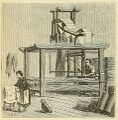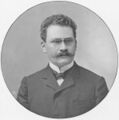Template:Selected anniversaries/January 12: Difference between revisions
No edit summary |
No edit summary |
||
| Line 1: | Line 1: | ||
<gallery | <gallery> | ||
||1577 – Jan Baptist van Helmont, Flemish chemist and physician (d. 1644) | |||
File:Pierre de Fermat.jpg|link=Pierre de Fermat (nonfiction)|1665: Mathematician [[Pierre de Fermat (nonfiction)|Pierre de Fermat]] dies. He is recognized for his discovery of an original method of finding the greatest and the smallest ordinates of curved lines, which is analogous to that of [[Calculus (nonfiction)|differential calculus]], then unknown. | File:Pierre de Fermat.jpg|link=Pierre de Fermat (nonfiction)|1665: Mathematician [[Pierre de Fermat (nonfiction)|Pierre de Fermat]] dies. He is recognized for his discovery of an original method of finding the greatest and the smallest ordinates of curved lines, which is analogous to that of [[Calculus (nonfiction)|differential calculus]], then unknown. | ||
||1777 – Hugh Mercer, Scottish-American general and physician (b. 1726) | |||
||1792 – Johan August Arfwedson, Swedish chemist and academic (d. 1841) | |||
||1822 – Étienne Lenoir, Belgian engineer, designed the internal combustion engine (d. 1900) | |||
||1866 – The Royal Aeronautical Society is formed in London. | |||
File:Jacquard loom with two children and a dog (circa 1877).jpg|link=Jacquard loom (nonfiction)|1875: Children reprogram [[Jacquard loom (nonfiction)|Jacquard loom]] to perform [[scrying engine]] functions. | File:Jacquard loom with two children and a dog (circa 1877).jpg|link=Jacquard loom (nonfiction)|1875: Children reprogram [[Jacquard loom (nonfiction)|Jacquard loom]] to perform [[scrying engine]] functions. | ||
||1876 – Jack London, American novelist and journalist (d. 1916) | |||
File:Jack London 1903.jpg|link=Jack London (nonfiction)|1876: Author [[Jack London (nonfiction)|Jack London]] born. He will become one of the first fiction writers to obtain worldwide celebrity and a large fortune from his fiction alone. | File:Jack London 1903.jpg|link=Jack London (nonfiction)|1876: Author [[Jack London (nonfiction)|Jack London]] born. He will become one of the first fiction writers to obtain worldwide celebrity and a large fortune from his fiction alone. | ||
File:Wild Man in Hydrogen Bubble Chamber.jpg|link=Time travel (nonfiction)|1901: [[Time travel (nonfiction)|Time travel chamber]] publishes autobiography. | |||
||1899 – Paul Hermann Müller, Swiss chemist and academic, Nobel Prize laureate (d. 1965) | |||
|File:Wild Man in Hydrogen Bubble Chamber.jpg|link=Time travel (nonfiction)|1901: [[Time travel (nonfiction)|Time travel chamber]] publishes autobiography. | |||
||1903 – Igor Kurchatov, Russian physicist and academic (d. 1960) | |||
||1908 – Clement Hurd, American illustrator (d. 1988) | |||
||1908 – A long-distance radio message is sent from the Eiffel Tower for the first time. | |||
File:Hermann Minkowski.jpg|link=Hermann Minkowski (nonfiction)|1909: Mathematician and academic [[Hermann Minkowski (nonfiction)|Hermann Minkowski]] dies. He showed that Albert Einstein's special theory of relativity can be understood geometrically as a theory of four-dimensional space–time, since known as the "Minkowski spacetime". | File:Hermann Minkowski.jpg|link=Hermann Minkowski (nonfiction)|1909: Mathematician and academic [[Hermann Minkowski (nonfiction)|Hermann Minkowski]] dies. He showed that Albert Einstein's special theory of relativity can be understood geometrically as a theory of four-dimensional space–time, since known as the "Minkowski spacetime". | ||
File:Neon lighting Ne symbol.jpg|link=Neon lighting (nonfiction)|1932: [[Neon lighting (nonfiction)|Neon lighting]] says that it "enjoys the work," calls itself "the luckiest of technologies" for a life spent converting [[Electricity (nonfiction)|electricity]] into [[Light (nonfiction)|light]]. | |||
||1916 – Ruth R. Benerito, American chemist and inventor (d. 2013) | |||
||1929 – Jaakko Hintikka, Finnish philosopher and logician (d. 2015) | |||
|File:Neon lighting Ne symbol.jpg|link=Neon lighting (nonfiction)|1932: [[Neon lighting (nonfiction)|Neon lighting]] says that it "enjoys the work," calls itself "the luckiest of technologies" for a life spent converting [[Electricity (nonfiction)|electricity]] into [[Light (nonfiction)|light]]. | |||
||1942 – World War II: United States President Franklin D. Roosevelt creates the National War Labor Board. | |||
||1958 – Charles Hatfield, American meteorologist (b. 1875) | |||
||1994 – Gustav Naan, Estonian physicist and philosopher (b. 1919) | |||
||1996 – Joachim Nitsche, German mathematician and academic (b. 1926) | |||
||2003 – Alan Nunn May, English physicist and spy (b. 1911) | |||
||2004 – Olga Ladyzhenskaya, Russian mathematician and academic (b. 1921) | |||
File:Deep Impact.png|link=Deep Impact (spacecraft) (nonfiction)|2005: [[Deep Impact (spacecraft) (nonfiction)|Deep Impact]] launches from Cape Canaveral on a Delta II rocket. It will be the first spacecraft to eject material from a comet's surface. | File:Deep Impact.png|link=Deep Impact (spacecraft) (nonfiction)|2005: [[Deep Impact (spacecraft) (nonfiction)|Deep Impact]] launches from Cape Canaveral on a Delta II rocket. It will be the first spacecraft to eject material from a comet's surface. | ||
</gallery> | </gallery> | ||
Revision as of 17:49, 12 August 2017
1665: Mathematician Pierre de Fermat dies. He is recognized for his discovery of an original method of finding the greatest and the smallest ordinates of curved lines, which is analogous to that of differential calculus, then unknown.
1875: Children reprogram Jacquard loom to perform scrying engine functions.
1876: Author Jack London born. He will become one of the first fiction writers to obtain worldwide celebrity and a large fortune from his fiction alone.
1909: Mathematician and academic Hermann Minkowski dies. He showed that Albert Einstein's special theory of relativity can be understood geometrically as a theory of four-dimensional space–time, since known as the "Minkowski spacetime".
2005: Deep Impact launches from Cape Canaveral on a Delta II rocket. It will be the first spacecraft to eject material from a comet's surface.




